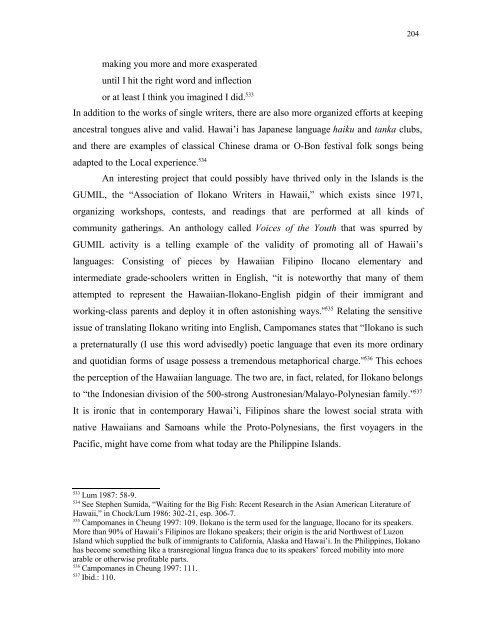A Paradise Lost - KOPS - Universität Konstanz
A Paradise Lost - KOPS - Universität Konstanz
A Paradise Lost - KOPS - Universität Konstanz
You also want an ePaper? Increase the reach of your titles
YUMPU automatically turns print PDFs into web optimized ePapers that Google loves.
making you more and more exasperated<br />
until I hit the right word and inflection<br />
or at least I think you imagined I did. 533<br />
In addition to the works of single writers, there are also more organized efforts at keeping<br />
ancestral tongues alive and valid. Hawai’i has Japanese language haiku and tanka clubs,<br />
and there are examples of classical Chinese drama or O-Bon festival folk songs being<br />
adapted to the Local experience. 534<br />
An interesting project that could possibly have thrived only in the Islands is the<br />
GUMIL, the “Association of Ilokano Writers in Hawaii,” which exists since 1971,<br />
organizing workshops, contests, and readings that are performed at all kinds of<br />
community gatherings. An anthology called Voices of the Youth that was spurred by<br />
GUMIL activity is a telling example of the validity of promoting all of Hawaii’s<br />
languages: Consisting of pieces by Hawaiian Filipino Ilocano elementary and<br />
intermediate grade-schoolers written in English, “it is noteworthy that many of them<br />
attempted to represent the Hawaiian-Ilokano-English pidgin of their immigrant and<br />
working-class parents and deploy it in often astonishing ways.” 535 Relating the sensitive<br />
issue of translating Ilokano writing into English, Campomanes states that “Ilokano is such<br />
a preternaturally (I use this word advisedly) poetic language that even its more ordinary<br />
and quotidian forms of usage possess a tremendous metaphorical charge.” 536 This echoes<br />
the perception of the Hawaiian language. The two are, in fact, related, for Ilokano belongs<br />
to “the Indonesian division of the 500-strong Austronesian/Malayo-Polynesian family.” 537<br />
It is ironic that in contemporary Hawai’i, Filipinos share the lowest social strata with<br />
native Hawaiians and Samoans while the Proto-Polynesians, the first voyagers in the<br />
Pacific, might have come from what today are the Philippine Islands.<br />
533 Lum 1987: 58-9.<br />
534 See Stephen Sumida, “Waiting for the Big Fish: Recent Research in the Asian American Literature of<br />
Hawaii,” in Chock/Lum 1986: 302-21, esp. 306-7.<br />
535 Campomanes in Cheung 1997: 109. Ilokano is the term used for the language, Ilocano for its speakers.<br />
More than 90% of Hawaii’s Filipinos are Ilokano speakers; their origin is the arid Northwest of Luzon<br />
Island which supplied the bulk of immigrants to California, Alaska and Hawai’i. In the Philippines, Ilokano<br />
has become something like a transregional lingua franca due to its speakers’ forced mobility into more<br />
arable or otherwise profitable parts.<br />
536 Campomanes in Cheung 1997: 111.<br />
537 Ibid.: 110.<br />
204

















